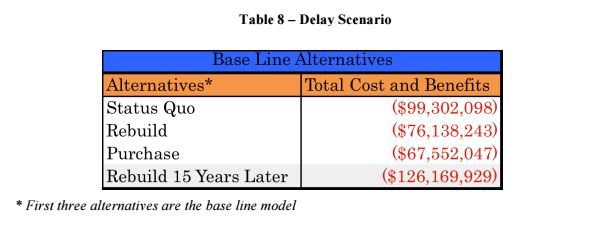Across the United States, the delivery of water services is an important public responsibility for municipalities. From treatment of the water at the source to its delivery to the end user, the proper functioning of these systems is important. Municipal policymakers are ensuring that this natural resource is being handled with a duty of care both to the environment and to their rate payers. In their efforts to ensure properly functioning water systems, municipalities face a similar quandary: because of constrained budgets, policymakers are forced to delay the implementation of necessary capital improvements for their water infrastructure systems. This delayed action results in aging of the water infrastructure components, which leads to costlier outcomes in the future. This is not the right course of action for municipal policymakers to take, and this endless cycle must be broken.
The City of Ithaca (located in the middle of the Central New York State region), even in the face of budgetary constraints, decided to take action to make improvements to their own water infrastructure system. Using Ithaca as a case example, this cost-benefit analysis outlines the economic and social ramifications of delaying water infrastructure improvements by examining specific costs associated with three options the city considered to improve its water infrastructure situation: economic costs, such as construction, operation and maintenance, and debt service; and environmental social costs, such as carbon emissions and water lost through water transmission to the end user. Through a discounted net-present value calculation, we projected project costs of the various options over a 20-year time horizon and ranked them according to their costliness. This analysis highlights the benefits of Ithaca’s decision to undertake improvements to its water infrastructure and articulates how other municipalities might handle this similar circumstance.
Why Are Municipal Policymakers Waiting to Make Water Infrastructure Improvements?
Today, municipalities are grappling with the challenges of providing multiple services – ones often with short-term and long-term focuses – while dealing with tightening, if not shrinking, budgets. As a result, instead of taking steps today to improve their aging water infrastructure, municipal policymakers often delay in responding to water infrastructure improvements – this means city government often only react to problems when they arise. This reactionary approach leads to frequent water main breaks or difficulty in meeting more rigorous water quality standards. To a lay person, this approach would be dismissed as ludicrous and baffling. Governments, however, do not operate in a vacuum: they face unforeseen circumstances that often require them to use more resources than originally allotted. Due to limited capital resources, it becomes clearer why policymakers are delaying making water infrastructure improvements, instead of taking proactive steps to stabilize these systems sooner.
The first reason is that water infrastructure improvements are very costly. Regardless of what policymakers decide to do for their water infrastructure systems, rehabilitating and maintaining existing systems is expensive. According to the United States Environmental Protection Agency (EPA), given the state of water infrastructure systems back in 2002, the total investment for improving water systems nationwide was projected to be over $335 billion from 2000 to 2019 (see Table 1). Over the same period, the Congressional Budget Office (CBO) found that the investment necessary to ensure safe drinking water would be between $11.6 billion and $20.1 billion annually.
In addition to the capital investments cited above is the need to operate and maintain these systems in the future. From 2000 to 2019, the CBO indicated that operation and maintenance costs would average in the range of $25.7 billion and $31.8 billion per year (see Table 2).

While these figures are daunting, some suggest that the true cost of infrastructure improvements are not even being calculated or shared with the public. According to the Johnson Foundation at Wingspread, calculated costs of water infrastructure improvements are not taking into account the influence of environmental issues, like climate change. While their own report does not acknowledge these additional cost figures, the Johnson Foundation recognizes that these projects may need to include more advanced techniques and technologies to adapt to water scarcity and other environmental conditions, like sediment runoff and storm water flooding. Therefore, cost estimates that once seemed daunting become even more astronomical when accounting for environmental pressures.
Policymakers’ approach to water infrastructure must also contend with a lack of sufficient funding to implement improvement projects. Nation-wide, municipalities have few options available to pay for necessary infrastructure improvements, and there has been limited federal support to help municipalities pay for these projects.
The last major injection of federal public spending on water infrastructure came with the American Recovery and Reinvestment Act of 2009. Even then, the level of support provided by the federal government fell far below the nation’s needs. Over the three-year period of this legislation, the government provided only $2 billion in aid to supplement the Drinking Water State Revolving Funds (DWSRF). DWSRF, a federal partnership with state governments, provides grant funding assistance ($316 million in grants since the program’s inception in 1996) to ensure the proper functioning of water infrastructure systems and safe drinking water. The New York State Department of Health estimated in 2008 that the statewide needs for non-New York City community water systems for the next 20 years was over $1.7 billion. Therefore, the federal government’s single injection of funding for the entire country would barely cover this one state’s water needs. Given the limited support from the federal government, state governments have also been hard pressed to provide sufficient support to municipalities for these improvements. Given current revenue levels, the only other way the state could make a larger contribution to supporting water infrastructure is by increasing tax rates to levels last seen in the 1980s.
The other method to fund infrastructure improvements is the water rates charged to end users by municipalities. Due to the limited support available from both federal and state levels of government, the burden of paying for operation and maintenance costs for water systems falls on water rate payers. While weather, water demand, and economic cycles continue to complicate the process of setting water rates in the first place, however, raising rates remains a prohibitively unpopular political move. Inexpensive water rates nationwide, however, contribute to persistent and widespread budget shortfalls in municipal water systems: 70% of water utilities fail to recoup their costs. Even if municipalities wanted to make up for water system shortfalls from raising rates, the political unpopularity of such a move leads to elected officials insisting, “not in my term of office.”
Financial and Water Infrastructure Conditions in Ithaca, New York
The issues surrounding water infrastructure policymaking on the local level are similar to those on the national level. For our case, the City of Ithaca, NY serves as a microcosm of the greater national issues that have been detailed above about water infrastructure improvements.
Ithaca is a city with a population of approximately 30,000 permanent residents, with an additional 30,000 transient residents comprised of undergraduate and graduate students from Cornell University and Ithaca College. Apart from these two institutions, Ithaca is home to several tax-exempt non-profit organizations. The result is a small tax base from which the City of Ithaca can earn revenues from tax-eligible properties. Consequently, Ithaca must prioritize where it spends the taxpayer dollars that it does earn. In recent years, the city has been forced to make budget cuts to vital services that the city provides to its residents, including capital investments in general infrastructure improvement projects. Its small tax base also prevents the city from receiving enough revenue to make crucial investments in its water infrastructure system. At present, the city charges $5.62 per cubic foot of water (equivalent to 748 gallons) used by its residents and commercial businesses. Among the seven types of Ithaca water customers (determined by pipe diameter size), the minimum aggregated total from all of the customer types would give the city approximately $23,200 per year. The lack of dependable funding sources to make investments into improving their water systems resulted in the situation the city faced.
The state of the City of Ithaca’s water infrastructure is concerning. According to their annual water quality reports, on a daily basis the city loses approximately 40% of the water it treats due to leaks in its distribution system. The city stands to lose money on the treated water that is not delivered to the end user. The city’s water treatment plant, located at the Six Mile Creek watershed, is over 110 years old, and many of the treatment technologies are inadequate to meet recently imposed water quality standards. For instance, the city of Ithaca is unable to meet current EPA water quality standards, which went into effect in 2009 — these include removing detergents and organic materials from the water source. In addition to the advanced age of its plant, the city has a distribution system comprised of pipes that are past their useful expectancy. The distribution system remains the primary source of water loss: Ithaca has experienced nearly 200 water main breaks in the last 30 years, a plurality of these occurring within the last 12 years. The conditions mentioned here are not sustainable, both financially and environmentally for Ithaca.
Cost-Benefit Analysis of Upgrades to Ithaca’s Water Treatment Plant
To test the advantages of proactive approaches to water infrastructure improvements, we conducted a cost-benefit analysis of three possible approaches (alternatives), and in addition scenario simulations involving the City of Ithaca’s water treatment plant. The analysis was ex-post, where in 2009 the City of Ithaca chose to construct a new water treatment plant. This analysis considered not only the financial factors but also the environmental consequences implicated in Ithaca’s water infrastructure upgrade. The model includes traditional financial measurements (i.e. capital improvement costs, operation and maintenance costs, etc.) as well as indicators that are not readily measured in dollars (i.e. social carbon costs associated with water treatment); all of these indicators were then converted into dollars in order to compare them. The net cost and benefits were calculated over thirty years and discounted to the year 2016. The model was used to analyze three alternatives:
- Status Quo: A passive approach that continues to use of the current (obsolete) water treatment plant
- Rebuild: Construction of a new water treatment plant, decommissioning and replacing the obsolete water treatment plant
Purchase: Decommissioning of obsolete water treatment plant and purchasing water from neighboring water system.

The analysis of the base-line alternatives revealed that the Status Quo alternative would be the most costly, due to the prohibitive costs of operating and maintaining the obsolete plant. The two latter alternatives were comparable to each other and significantly less costly than maintaining the status quo. Our analysis found that total cost to the City of Ithaca of not upgrading the current water treatment plant was nearly $100 million. The option the city has ultimately chosen to pursue (rebuilding the water treatment plant) appears about 25% less costly to the city than the status quo, at about $76 million: the large capital costs of constructing a new water treatment plant are still less than the costs of maintaining aging infrastructure. Although the Rebuild alternative was chosen, this analysis suggests it was not the best option for the City of Ithaca.
From these base alternatives, we tested various simulations, such as increasing construction costs, increasing capital costs (i.e. higher interest rates), increasing operation and maintenance costs, and increasing water rates.
The first simulation demonstrates the cost of delayed action. In Table 4 below, increasing the cost of construction between 1% and 5% did not significantly diminish the cost advantage of building a new treatment plant or constructing a new mainline to receive purchased water, relative to using the current treatment plant. Using the current system would still be costlier to the City of Ithaca over the other two options.

The second simulation demonstrates the rise in interest rates. In Table 5, when interest rates for borrowing significantly increased (up to 9.5%), the cost of constructing a new water treatment plant was still less costly than maintaining the current water treatment plant, by about $10 million. Once again, even when the simulated scenario would negatively impact the proactive approaches while holding the status quo constant, the Status Quo alternative does not become more favorable than the two latter alternatives.
 The third simulation demonstrates of the increase in operation and maintenance costs. In Table 6 below, increasing operation and maintenance costs revealed that the Status Quo alternative’s cost to the city would be enormous, especially when compared to the other proactive options. In fact, the difference between the alternatives of continuing the status quo versus building a new water treatment plant could be as high as approximately $75 million in favor of rebuilding.
The third simulation demonstrates of the increase in operation and maintenance costs. In Table 6 below, increasing operation and maintenance costs revealed that the Status Quo alternative’s cost to the city would be enormous, especially when compared to the other proactive options. In fact, the difference between the alternatives of continuing the status quo versus building a new water treatment plant could be as high as approximately $75 million in favor of rebuilding.

The fourth simulation demonstrates the impact of rising water rates. In Table 7 below, when we tested the effect of increasing water rates, once again the proactive approaches were significantly better in how they fared in this simulation. As rates are increased, however, the Purchase alternative is no longer the optimal alternative by a small margin and only after the high end of our year after year growth rate.

Finally, we simulated a delay in constructing the city’s new treatment plant. We devised a scenario in which construction of a water treatment plant was delayed for fifteen years, essentially a compromise between proactive and passive actions. As is seen in Table 8 below, the cost of delay was much higher than our proactive approaches in our base model, at approximately $126 million. Lessons for Municipalities
Lessons for Municipalities
This example regarding the City of Ithaca provides lessons relevant for municipalities across the country. Municipalities should recognize and address infrastructure issues as they arise, as the price paid for waiting is greater than the price paid today. To facilitate municipalities’ proactively maintaining and modernizing infrastructure, more creative funding and financing solutions are needed to pay for infrastructure projects outside of the conventional means of assessing taxes and water rates.
Lesson # 1 – The Price Paid for Waiting is Greater than the Price Paid Today
Our findings suggest that the more valuable dollar today should be invested in infrastructure that would be less costly today than in the future. The analysis has shown that the price of making capital improvements to water systems later is greater than making them today. While policymakers examine these projects at today’s cost levels, it is very important to examine a project to determine how much costlier it would be tomorrow in today’s dollars. That way, this provides an important perspective to policymakers to plan accordingly to make these key capital investments when they must occur.
Lesson # 2 – Recognize and Address Infrastructure Issues Sooner rather than Later
It is far better to address infrastructure issues today than tomorrow. Our analysis establishes that the longer municipalities wait to make critical capital improvements to their water systems, the greater the long-term consequences. Delaying these decisions presents not only economic ramifications but also environmental costs. The loss of water through leaky pipes and connections, for example, makes preserving the future availability of water resources more difficult. Environmental stakeholders would not only call this mode of response concerning, but irresponsible. In areas where there is more pressure being placed on elected officials and policymakers to make key investments in their water systems to prevent the waste of a finite resource, it behooves policymakers to make these decisions today to reap the benefits explained earlier and evade public criticism for their lack of environmental stewardship.
Lesson # 3 – Prioritize Creativity in Funding and Financing Infrastructure Projects
Conventionally, municipalities pay for their water infrastructure projects using tax and water rate revenues; however, we have seen that these revenues are insufficient to cover the costs of these projects. Therefore, municipalities must think more creatively (whether directly funding or structuring their debt capital) to pay for water infrastructure projects. Luckily, more innovative debt instruments have been developed to help pay for such projects. One rapidly expanding debt market is green bonds, which can help pay for projects that address issues of environmental sustainability. Since preserving the future use of water resources is in itself a key environmental pursuit, municipalities could gain access to this type of bond financing to pay for the upfront cost of water infrastructure improvements. For example, the District of Columbia Water and Sewer Authority issued a $350 million green bond with a 100-year maturity in 2014 to improve the city’s wastewater management. The green bond approach is an alternative to the method of funding infrastructure projects through conventional means of water user fees. Another route is for municipalities to use the public-private partnership model to leverage its own public dollars with private sector funding for these projects. For instance, Seattle Public Utilities, like the City of Ithaca’s water utility, was faced with adhering to new EPA water quality standards. Despite this daunting reality, Seattle worked with CH2M HILL to develop a new 180 million gallons per day water treatment facility equipped with ozonation and ultraviolet treatment technologies. Through this partnership, Seattle reduced its operation and maintenance costs by eliminating the use of outdated water treatment processes. While there is outward opposition to private sector intrusion into public sector services, the private sector can assist the public sector in meeting its social and environmental objectives to provide quality water services.
Maintaining municipal water infrastructure systems can be a daunting task. Balanced against reduced budget flexibility and lower funding support for infrastructure projects, municipalities are forced to delay vital improvements to these systems. If municipal policymakers continue to react to water infrastructure issues, however, this delay will result in higher costs over time. As the example of the City of Ithaca has shown, taking action helps municipalities avoid added costs in the future. If municipal policymakers want to avoid the future economic and environmental costs in delaying action, they must make decisions today to improve their water infrastructure systems.





